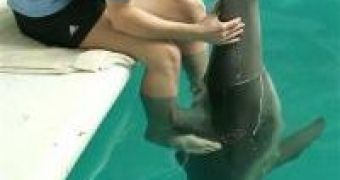Every year, thousands of dolphins get entangled in fishing nets, resulting in their death by asphyxia or injures which finally lead to the same end.
Recently, hope has risen for some of the injured dolphins. Marine scientist Steve McCulloch, director of dolphin and whale research at the Harbor Branch Oceanographic Institution, has confronted with the situation of a baby bottlenose dolphin from Indian River Lagoon (near Cape Canaveral) which lost her tail, but perhaps her life could be saved.
McCulloch channeled his anger into a solution: a prosthetic tail. Winter (how is dubbed the young dolphin) would be the first dolphin to benefit a whole tail prosthesis, giving her more power on the tail movement. "There's never been a dolphin like her," said Dana Zucker, chief operating officer of the Clearwater Marine Aquarium, which is now Winter's home.
First dolphin prosthesis was installed to a dolphin in Japan who lost just a part of its tail. Fuji, from an aquarium in Okinawa had part of his tail remaining on which to attach a prosthesis. A fisherman found the little dolphin in December, being very frail and dehydrated and just 3-month-old, tangled in the buoy line of a crab trap. The line strangled the blood circulation to her tail flukes. "It looked like paper," Zucker said of Winter's tail. "Bit by bit over the weeks it just fell off."
Winter was left with a rounded stump. More than 150 volunteers and veterinarians spent months curing Winter. She was fed with a special mix of infant formula and pureed fish.
Winter learned how to swim without her tail with a combination of moves that resemble a crocodile's undulations and a shark's side-to-side tail swipes, using her flippers, normally employed for steering and braking, to get moving. This swimming method could be harmful on Winter's spine.
Winter can't reach the normal speed of wild dolphins, up to 25 km/h, which swim with strokes of their tail flukes. Even if she gets a prosthetic tail, she will remain in captivity for life. Apart from that, Winter is equally playful and active, just like other dolphins of her age.
The team has been consulting with a diving gear manufacturer, a tire company and the Navy, which has experienced attaching items to dolphins for military research.
It is not clear how the prosthetic tail would be attached to her stump, but this should be tough. "The dolphin's tail fin is the most powerful swimming mechanism Mother Nature ever designed," McCulloch said. "When you see how much pressure they put on their flukes, the prosthesis is going to take a marvel of modern engineering."
As she grows, Winter would need at least three Tails. She is now about 4 feet long and weighs 110 pounds. When she is full grown at age 15, Winter will be twice as long and four times as heavy.
The cost of the prosthetic tail is a big problem. "All I know is Fuji's tail cost $100,000 - and that was in 2004," McCulloch said.
"That's equal to the entire monthly operating budget of the Clearwater Marine Aquarium," Zucker said. And the small animal hospital relies mostly on volunteer workers; its roof leaks in heavy rains. "It's a labor of love." Zucker said.
The volunteers expect the design cost of the tail will be sponsored by the creating company. They are already making a huge effort with the long cost of caring the injured animals.
Winter is a living proof of the results of neglectful fishing methods. "The kids get it right away. It's the adults, more creatures of habit, who take more persuasion," McCulloch said. "You can't outlaw fishing line, but you can educate a fisherman not to use careless techniques such as tossing out line."
Photo credit: Chris O'Meara/AP

 14 DAY TRIAL //
14 DAY TRIAL //